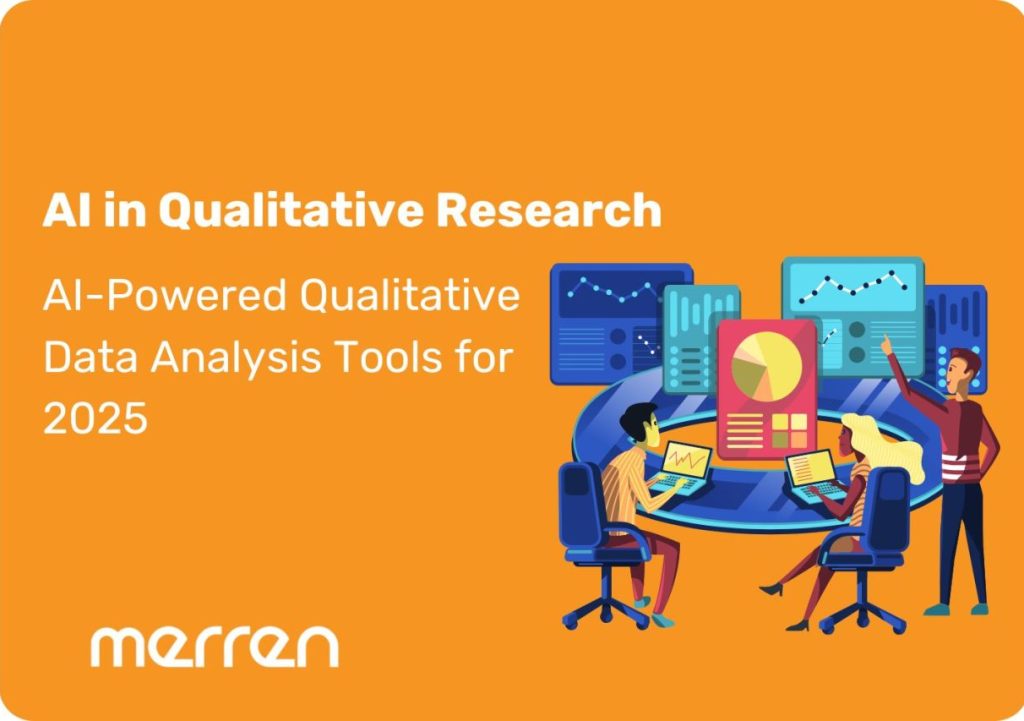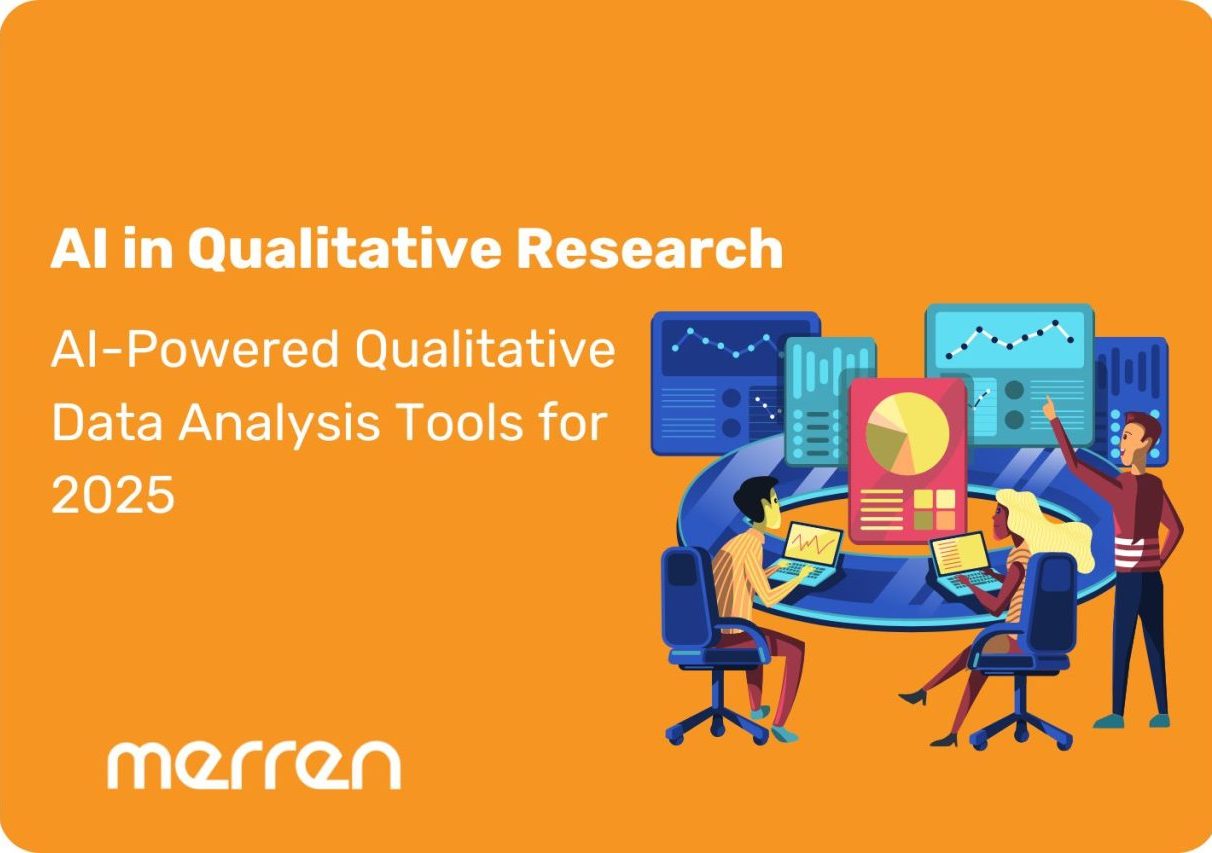Digital qualitative research is undergoing a step-change thanks to AI that can compress days of manual analysis into hours. It can reveal patterns across messy, multi-modal data and unlock the voice of the customer in their own words. For market researchers, the opportunity is clear: adopt AI-powered qualitative data analysis (QDA) tools to move faster without sacrificing rigor, while staying closer to real customer intent and emotion.
Why AI for Qualitative Research Now
Scale and speed
AI can transcribe large volumes of digital qualitative research data which includes
interviews, calls, chats, and open-ended survey responses. AI driven analysis is far faster than manual workflows and turns analysis cycles from weeks into days or hours.
Sentiment detection
Modern AI combines speech-to-text with sentiment, tone, and entity detection to extract what people mean, not just what they say. It captures emotion, sarcasm, and intent from voice data.
AI co-pilot
Tools now include “AI Assistants” that auto-suggest codes, summarize themes and redact PII. It enables analysts to “chat with documents” to probe patterns across sources using natural language.
Enterprise readiness:
Leading platforms highlight compliance options (GDPR/CCPA/HIPAA) and collaboration. Qualitative insights can be shareable across teams and defensible in governance contexts.
Leading AI-Powered Qualitative Data Analysis Tools
Here’s an overview of notable AI-assisted research platforms in 2025 and what they are best suited for.
1. Classic CAQDAS platforms with modern AI
NVivo, MAXQDA, ATLAS.ti remain the “big three” in qualitative research software, now enhanced with AI-powered transcription, auto-coding, and sentiment analysis.
- MAXQDA positions itself as an all-in-one QDA solution with “AI Assist”. It can accelerate tasks across interviews, literature review, mixed methods, and presentation workflows.
- ATLAS.ti emphasizes conversational AI (“chat with your documents”). It enables AI-powered coding, sentiment analysis and entity recognition. The platform offers deep query tools, all within a collaborative platform.
- NVivo is recognized in market roundups for introducing AI-driven auto-coding and sentiment features to increase throughput on large datasets.
Best for: Academic researchers and teams needing rigorous mixed-methods capabilities within established QDA environments.
2. Research repositories and insight platforms with AI
Dovetail centralizes interviews, calls, tickets, and surveys into a searchable repository. Its AI features such as Magic Summarize, Magic Transcribe, and Magic Highlight speed up transcription, redaction, summarization, and pattern detection.
Best for: Product, UX, and customer research teams that want a collaborative, searchable repository for qualitative insights.
3. AI-first voice and conversational qual platforms
Merren is an AI-powered market research platform that conducts voice surveys and analyzes responses in real time. It has tools that capture tone, emotion, and intent directly from the customer’s voice to deliver insights within hours.
- Voice responses: Customers respond in their own voice across channels (including WhatsApp). It is easy to participate and collects spontaneous qualitative signals.
- AI analysis: The AI can bring automatic speech-to-text transcription, sentiment detection (positive/neutral/negative), tone cues (e.g., enthusiasm, sarcasm), theme clustering, and word clouds. All real-time data is available on a centralized dashboard.
- Operational speed: Real-time and campaign-long analytics accelerate decision-making for CX, marketing, and product teams often without specialized analyst support.
Best for: Brands seeking authentic, at-scale voice of the customer (VoC) insights for CX, creative, and product strategies.
Choosing the Right Qualitative Data Analysis Tool
- If you are a researcher looking for academic-grade tools that use complex mixed-methods, choose MAXQDA or ATLAS.ti. It offers robust coding structures, flexible queries, and AI assistance that still fits rigorous methodologies
- If your aim is to seek product or UX related research, Dovetail enables centralized storage, AI summarization, redaction, and highlight reels. This platform also encourages cross-team sharing.
- If you seek voice of the customer (VoC) qualitative data, choose Merren CX. Merren can capture genuine spoken feedback, analyze tone and sentiment quickly. This AI-powered digital qualitative research tool can make decisions across industries in various languages and deploy surveys across channels.
Tips for Better AI-Assisted Qualitative Research
1. Start with a business goal
Define what decisions the insights will collect. It could be brand positioning, customer mapping journey gaps or notes about service recovery. Choose a goal and then shape collection and coding strategies accordingly.
2. Use AI as your jetpack
Use AI for speech transcription, auto-coding, clustering. Add analyst judgment to validate themes, nuance interpretations, and ensure ethical context. AI-powered tools are meant to augment manual efforts. It is not a replacement but a jetpack that can help you scale your research.
3.Pilot, iterate and scale
Begin with a targeted project such as churn calls, post-launch feedback. Replicate AI-powered results on a larger scale of research. Then expand to more channels and segments
4. Measure time-to-insight
Track how quickly insights move from collection to decision-making. AI should significantly reduce this time, especially in voice-led research.
Conduct Digital Qualitative Research with Merren CX
Voice-first qualitative: Capture real customer emotion and context using more than text. Collect voice of the customer (VoC) via audio across 80+ languages and familiar channels including WhatsApp and Facebook messenger.
Hours-to-insight: AI-driven analysis delivers sentiment, tone, and themes rapidly so CX and marketing teams can act in the same campaign cycle.
Simplicity with depth: No-code setup, centralized dashboards, and export options. The ability to drill down to each respondent’s synopsis and source audio when needed.
To see how AI-powered voice surveys can transform qualitative research and CX programs, visit merren.io and explore how to turn the voice of the customer into immediate, actionable insight

